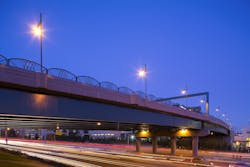No. 2 - I-405 in Washington
So far the master plan is going according to plan.
Since commencing the I-405 Master Plan in 2002—which looks to ease congestion on one of Washington state’s busiest roadways—the Washington State Department of Transportation (WSDOT) has completed 13 of the 150 total projects, all on schedule and under budget. The department hopes to continue the streak with No. 14: the I-405 Bellevue to Lynnwood Widening and Express Toll Lanes project.
Congestion is so bad on this segment of I-405 because it is one of just two major north-south routes through the Seattle area. It carries an estimated 950,000 trips per day, which quickly adds up to 8 hours of congestion per day. And the problem is only expected to get worse, increasing to 1.5 million trips per day by 2030.
The Bellevue-to-Lynnwood project will attempt to lighten the load at the point where S.R. 167 joins the interstate by implementing the new Vision all-electronic tolling system. There are currently high-occupancy vehicle (HOV) lanes in place along the route, but according to Kim Henry, WSDOT’s I-405 program director, “Today’s lanes are not performing up to our standards of maintaining speeds of at least 45 mph at all times.”
Work on the $155 million Lynnwood-to-Bellevue portion began in 2012, with the goal of adding a new express toll lane between Northeast Sixth Street in Bellevue and S.R. 522 in Bothell. At the same time, crews are converting the existing HOV lane between S.R. 522 and I-5 to a single express lane to create a dual-lane system. For actual tolling purposes, the segment will be broken into three dynamic pricing zones. The ultimate goal is to maintain that minimum speed of 45 mph. Non-tolled lanes will still be available for those not wishing to pay.
Implementing the Vision tolling system means upgrades are required to the existing intelligent transportation system, including new closed-circuit television cameras. “The end goal is picking up more data to help with freeway management,” Henry said.
With the new lanes comes a series of braided ramp interchanges between Northeast 160th Street and S.R. 522. The ramps will separate merging traffic from regular interstate traffic and create additional spacing for drivers to get to their lane. “We’ve used the design in other spots around the area and it’s worked well for us,” Henry told Roads & Bridges.
As is often the case with major road construction, the project team had to be mindful of the surrounding environment—both natural and manmade. Working closely with the local communities, WSDOT has installed a number of stormwater treatment measures, including eight new treatment and detention ponds and more than a half-mile of bioswales, which filter stormwater runoff with organic material.
To make the situation more tenable for residents, the project team is installing seven brand-new noise walls and a noise berm.
While the Bellevue-to-Lynnwood project is expected to wrap up late next year, the future of the I-405 Master Plan beyond that is foggy due to diminishing gas-tax funding. As a result WSDOT expects the new toll lanes to be a primary source of revenue going forward—as soon as phase 2 of the Vision project, which is currently unfunded. R&B
Project: I-405 Bellevue to Lynnwood Widening and Express Toll Lanes Project
Location: Bellevue and Lynnwood, Wash.
Owner: Washington State Department of Transportation
Designer: URS Corp.
Contractor: Flatiron Constructors
Cost: $155.5 million
Start Date: February 2012
Completion Date: December 2015
